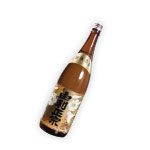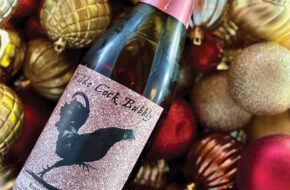
As it has trickled down from the aristocracy to the people, it has gained refinement, complexity, and variety. Here is a scouting report on five of Izakaya’s selection of 50 fine sakes (click here to read a detailed review of Izakaya—the hot new restaurant at the Borgata).
“Sake is such an important part of eating in Japan I tried to incorporate it into all aspects of the dining experience at Izakaya,” says chef/owner Michael Schulson. Sake charts a course from cocktails to appetizers (the truffled broth for edamame dumplings), dinner (the soak for deep-fried edible fluke skeleton), and dessert (the zip in strawberry shortcake).
What grapes are to wine, rice is to sake. There are dozens of varieties of sakamai, or sake rice. Ginnosei, the rice used to brew Ama no To’s Heaven’s Door, is a hybrid developed to withstand the fierce winters of Akita, the prefecture on the northwest coast of Japan where this sake is made.
Compared to table rice, sakamai has larger grains with a bigger shinpaku (white heart), the starch packet in the center. Milling polishes away the exterior proteins, oils, and minerals that would create off-flavors if brewed. Anywhere from 30 to 60 percent or more of the outer surface is polished away. Generally, the higher the degree of polishing, the more complex, fragrant, and expensive the resulting sake.
In ancient Japan, rice was polished by chewing (and, yes, spitting out), which also introduced the enzyme that changes the starch to sugar. Today, breweries use computer-controlled machines. The brewing process (called multiple parallel fermentation) involves yeast as well as the enzyme, and is more complex than that of beer. Most sakes (including the five below) are filtered and pasteurized. Whether to drink sake warm or chilled “is completely up to a customer’s taste,” says Izakaya manager Craig Slotkin. “There is no right or wrong temperature.”
Schulson’s commitment seems to be paying off. “Sake actually outsells wine and beer at Izakaya,” he says.
NAME: Living Jewel
BREWERY: Tozai
LOCATION: Kyoto (S Central)
GRADE: Junmai (pure rice, no alc. added)
COLOR: Pale Hay
BODY: Medium
FLAVOR: Red delicious apple; hints of tangy fruit
NOSE: Subtle, earthy, wet oak leave
ALCOHOL: 14.9%
SERVING SIZE/PRICE: 8 oz. carafe, $12; 22 oz. carafe, $32
GREAT WITH…: Sushi, especially oily fish salmon
COMMENTS: "Earthy yet subtle."
*******
NAME: Dreamy Clouds
BREWERY: Rihaku
LOCATION: Shimane (SW coast)
GRADE: Tokubetsu (reserved) junmai
COLOR: Milky White
BODY: Full, round, milky
FLAVOR: Ripe melon, tropical fruit, low acidity
NOSE: Wet slate, mountain stream
ALCOHOL: 15.5%
SERVING SIZE/PRICE: 8 oz. carafe, $10; 22 oz. carafe $27
GREAT WITH…: Spicy or highly acidic foods
COMMENTS: "High quality at an entry-level price."
*******
NAME: Yuri Masamune
BREWERY: Yuki No Bosha
LOCATION: Akita (NW coast)
GRADE: Daiginjo (finest brewing art)
COLOR: Semi-clear
BODY: Crisp, clean, lean
FLAVOR: Starfruit, kumquat, minerals
NOSE: High minerality
ALCOHOL: 17%
SERVING SIZE/PRICE: 8 oz. carafe, $11; 22 oz. carafe, $30
GREAT WITH…: All sushi
COMMENTS: "The most poignant on your palate of our carafe sakes."
*******
NAME: HoHo Shu
BREWERY: Marumoto
LOCATION: Okayama (SE coast)
GRADE: Sparkling junmai
COLOR: Bubbly, faintly milky
BODY: Rich, smooth, frothy
FLAVOR: Honeysuckle; notes of peach
NOSE: Fragrant fruit; cherry blossom
ALCOHOL: 6%
SERVING SIZE/PRICE: 300 ml. bottle, $27
GREAT WITH…: Spicy small dishes, grilled vegatables
COMMENTS: "A novel new entry on the market."
*******
NAME: Heaven’s Door
BREWERY: Ama No To
LOCATION: Akita (NW coast)
GRADE: Tokubetsu junmai
COLOR: Clear, slight shine
BODY: Medium to full
FLAVOR: Refreshing, hints of cucumber, squash
NOSE: Parsley, cilantro, tarragon, chervil
ALCOHOL: 16.2%
SERVING SIZE/PRICE: 8 oz. carafe, $22; 22 oz. carafe, $59
GREAT WITH…: Heartier dishes like the seafood stew
COMMENTS: "Herbaceous, sophistocated; from a great producer."
Note: All comments by Randall Mrazik, Izakaya Gen. Mgr.
By submitting comments you grant permission for all or part of those comments to appear in the print edition of New Jersey Monthly.






